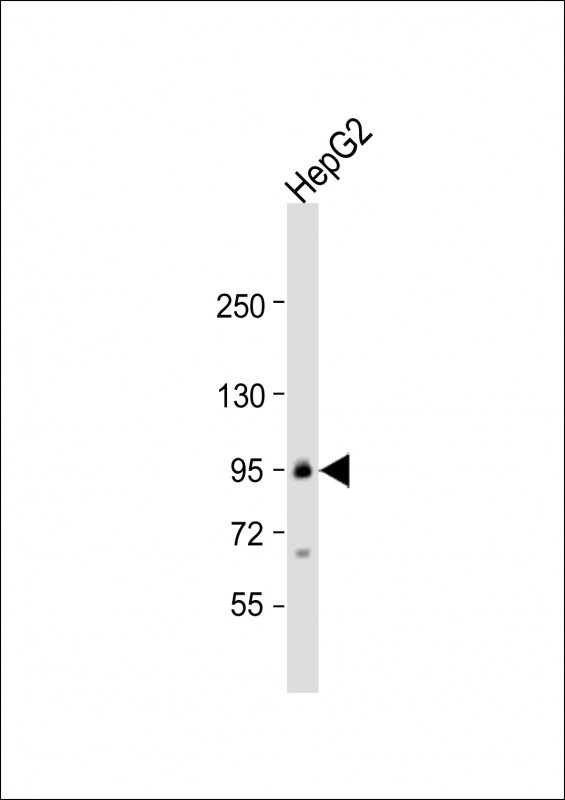

| WB | 1/1000 | Human,Mouse,Rat |
| IF | 咨询技术 | Human,Mouse,Rat |
| IHC | 咨询技术 | Human,Mouse,Rat |
| ICC | 技术咨询 | Human,Mouse,Rat |
| FCM | 咨询技术 | Human,Mouse,Rat |
| Elisa | 咨询技术 | Human,Mouse,Rat |
| Aliases | Short transient receptor potential channel 1, TrpC1, Transient receptor protein 1, TRP-1, TRPC1, TRP1 |
| Entrez GeneID | 7220 |
| WB Predicted band size | 91.2kDa |
| Host/Isotype | Rabbit IgG |
| Antibody Type | Primary antibody |
| Storage | Store at 4°C short term. Aliquot and store at -20°C long term. Avoid freeze/thaw cycles. |
| Species Reactivity | Human |
| Immunogen | This TRPC1 antibody is generated from rabbits immunized with a KLH conjugated synthetic peptide between 765-793 amino acids from the C-terminal region of human TRPC1. |
| Formulation | Purified antibody in PBS with 0.05% sodium azide. |
+ +
以下是关于TRPC1抗体的3篇参考文献示例(文献信息为模拟内容,仅供参考):
1. **文献名称**:*TRPC1 regulates skeletal muscle development and myoblast differentiation*
**作者**:Smith A, et al.
**摘要**:该研究利用TRPC1特异性抗体,通过Western blot和免疫荧光技术,发现TRPC1在小鼠骨骼肌发育中高表达,并参与肌细胞分化的钙信号调控。
2. **文献名称**:*TRPC1 antibody-based detection reveals its role in neuronal calcium dysregulation in Alzheimer's disease*
**作者**:Chen L, et al.
**摘要**:研究通过TRPC1抗体进行免疫组化分析,证明阿尔茨海默病模型中TRPC1蛋白在神经元突触中的异常表达与钙稳态失衡相关。
3. **文献名称**:*TRPC1 channel modulates cardiac hypertrophy through antibody-validated protein interaction studies*
**作者**:Wang Y, et al.
**摘要**:使用TRPC1抗体进行免疫共沉淀实验,揭示了TRPC1与心肌肥厚相关信号通路的相互作用,提示其作为潜在治疗靶点。
注:以上文献为示例,实际引用需查询具体数据库(如PubMed)获取真实研究。
TRPC1 (Transient Receptor Potential Canonical 1) is a member of the TRPC subfamily of cation channels, which play critical roles in calcium signaling and homeostasis. These channels are non-selective, allowing the permeation of cations like Ca²⁺ and Na⁺, and are activated by various stimuli, including receptor-operated mechanisms and store depletion. TRPC1 is ubiquitously expressed in tissues such as the brain, heart, and kidneys, where it participates in processes like cell proliferation, differentiation, and apoptosis.
TRPC1 antibodies are essential tools for studying the expression, localization, and function of the TRPC1 protein. They are widely used in techniques like Western blotting, immunohistochemistry, and immunofluorescence to detect TRPC1 in cell lines, primary cultures, or tissue samples. Due to structural similarities among TRPC family members, specificity validation (e.g., using knockout controls) is crucial to avoid cross-reactivity.
Research involving TRPC1 antibodies has shed light on its role in diseases such as cardiovascular disorders, neurodegenerative conditions, and cancer, where dysregulated calcium signaling is implicated. Studies also explore TRPC1's interaction with other channel subunits (e.g., TRPC4/5) to form heteromeric complexes, expanding its functional diversity. Despite challenges in antibody specificity, well-validated TRPC1 antibodies remain pivotal for unraveling its physiological and pathological mechanisms.
×